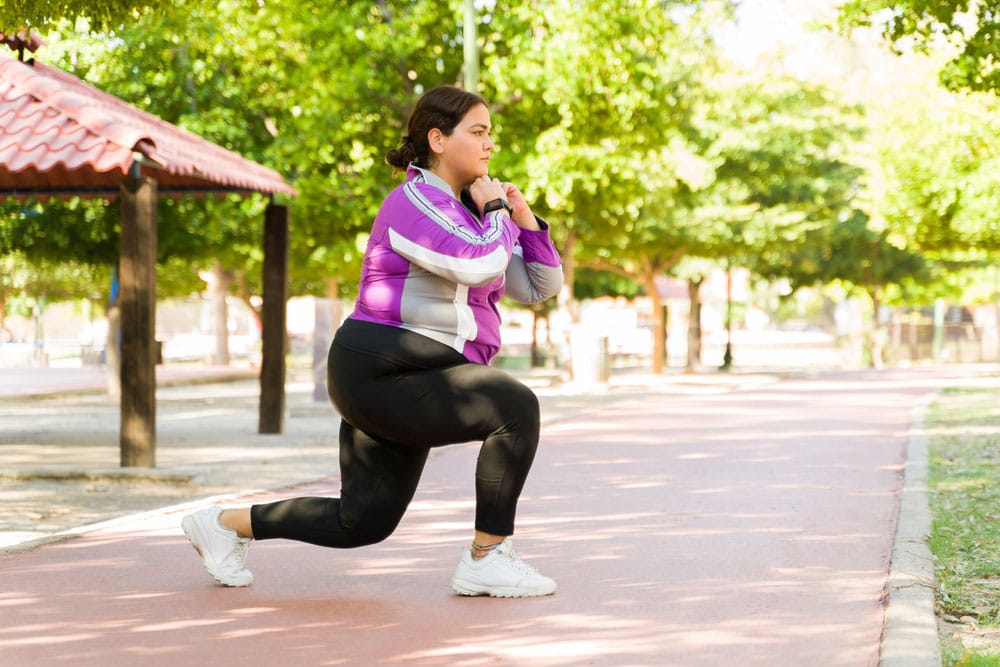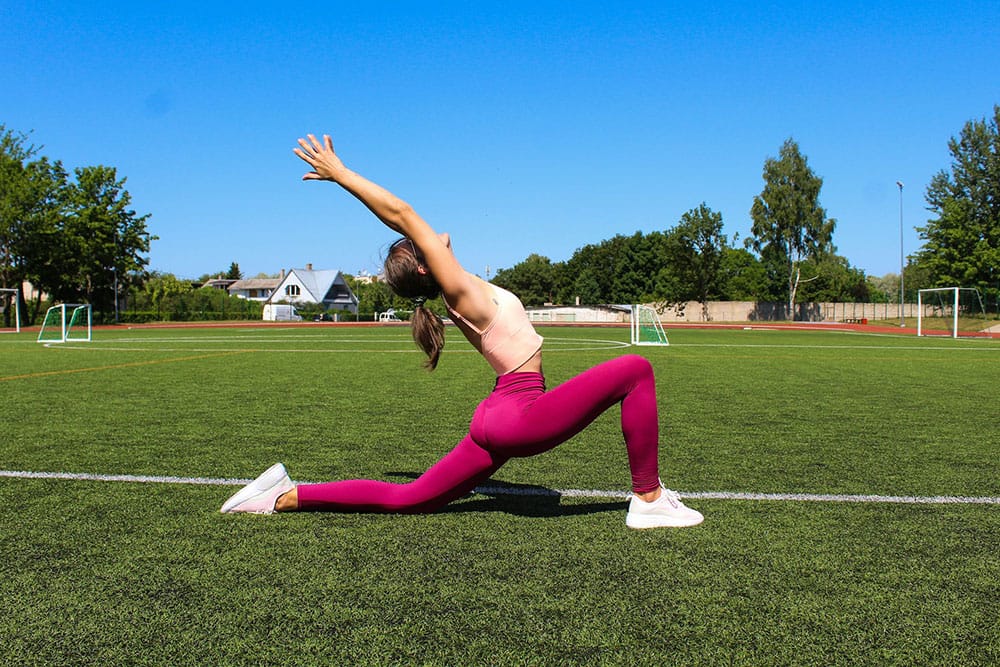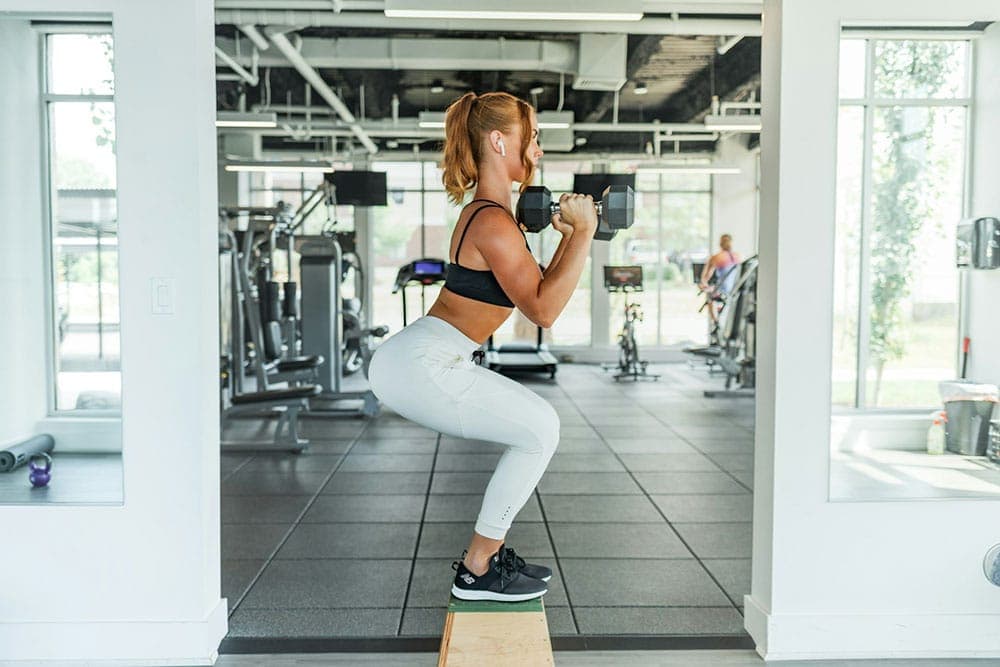Lunges vs. Squats: What’s the Ultimate Move for Strong Legs?
Learn the differences and benefits of lunges vs. squats. Find out which move is best for you based on your goals.
Lunges and squats are two moves that are second to none for getting your upper body strong and toned. But which move is more beneficial in a lunges vs. squats comparison?
But although they’re pretty different exercises, people tend to use squats and lunges for the same reasons when it comes to strength training.
Building up your lower body muscles can take a lot of effort. Especially if you’ve got a pancake butt and are pretty much starting from scratch.
But it’s a shame to use these moves in the same way when each comes with a host of very different benefits.
How to Squat
- Set-Up: Stand with your feet shoulder-width apart or slightly wider. Point your toes out slightly at around a 15-degree angle. Engage your core muscles and keep your spine neutral. Hold your chest proud.
- Equipment: Place a loaded barbell across your upper back. The bar should sit across the tops of your trapezius muscles. Grip the bar with your hands facing forward. Keep them slightly wider than shoulder-width apart.
- Squat: Hinge from your hips as you bend your knees. Think about making the motion of dropping back to sit on a chair. Keep your weight on your heels and lower your body down until your thighs come to a 90-degree angle with your shins. Make sure your knees are tracking in line with your toes and that they don’t knock inward.
- Reverse: Drive out of your heels, and push the floor away from you to come back up. At the top of the move, extend your hips and squeeze your butt slightly.
- Reps: Beginners should aim for 3 sets of 10 reps. If you’re squatting for strength, aim for 3 sets of 3-6 reps or try a one-rep max with heavy weight. If you’re squatting for hypertrophy, aim for 3 sets of 8-12 reps.
For more recommendations on squat load, see Loading Recommendations for Muscle Strength, Hypertrophy, and Local Endurance.
How to Lunge

- Set-Up: For a standard lunge, stand in a split stance with your right leg in front of your left. Place your hands on your hips for stability. Engage your core and keep your body upright with your chest proud and a neutral spine.
- Lunge: Bend your knees and lower your body down until the back knee hovers just above the floor. This should bring both your knees to a 90-degree bend. Keep your weight distributed equally between both legs.
- Reverse: Drive out of your front heel to push your body back up to a standing position. This is one rep. Complete one set of 10 with the right leg in front of you, then switch legs and complete 10 with the left leg in front. This makes one full set.
- Reps: Repeat for 3-4 sets of 10 reps per leg.
Squat Benefits
Strength
Squats are the best move you can do for total power. This compound exercise recruits everything from your glutes, hamstrings, and quads to your core and abdominal muscles.
If you’re doing a barbell squat, they can even have an effect on your upper body, since you need to keep your chest proud and use your upper back to secure your weight. Squat weight is used as a key determinant of strength in sports like Olympic lifting and powerlifting.
In these sports, your squat weight is a crucial test: it proves if you’re strong or not at a competitive level.
Range of Motion
Provided you are doing the full variation correctly, squats generally have a slightly larger range of motion than lunges.
This move really allows you to challenge your hip flexor muscles and test mobility in your ankles. Dropping your ass to grass during squats is a very intense movement for your knees and ankles.
Although you need good knee and ankle mobility as well, it often feels gentler on these joints than squats.
Athletic Performance

Squats translate more directly to sports performance than lunges do.
You use some degree of squatting motion any time you run or jump. You also keep a light bend in your knees when you’re bracing yourself for action in sports like basketball or baseball.
All of this is a (very slight) type of squat.
In order to perform better in explosive movements that will help you with activities like high jump or sprinting, the squat edges out the lunge in terms of functionality.
Lunge Benefits

Unilateral Training
Lunges let you train with one leg in front and then the other.
Working on opposite sides of the body in an alternating pattern is called unilateral training. What’s the benefit of unilateral training?
Using single-sided exercises helps you to correct muscle imbalances in your body. If you struggle with strength on one side, it’s a good way to help your muscles correct their activation patterns and balance out the work of your body.
There’s also some indication that unilateral exercises help sports performance, at least in moves where you need to do unilateral jumps. In a study on the effects of unilateral vs. bilateral resistance training, researchers found that unilateral exercises are effective in training moves where you jump or drive yourself from one leg.
This can be useful for sports like sprinting.
Core Strength and Stability

Because they require you to hold your balance with your legs in a split stance, lunges are a great core strengthener.
Engaging your core muscles helps keep your torso stable. The abdominals help you maintain proper posture as you drop down into a lunge. but they can improve your core strength outside the gym too. You’ll feel more stable and oftentimes your balance will improve too.
Core strength impacts most types of athletic performance. It helps you hold onto your balance so you can kick, throw, swing and catch more efficiently using your limbs.
You don’t have to worry about just staying standing if your core is highly engaged and functional. Plus, it’s important in your everyday life, especially as you age
Do squats and lunges work the same muscles?
Squats and lunges essentially work the same muscles but at different capacities.
Both of these moves work some major common muscles. Let’s take a look at them.
Quadriceps
Sitting on the front of your thighs, your quadriceps (aka “quads”) engage as you squat or lunge especially as you push up from the bottom of either move.
Hamstrings
Your hamstrings help you stay stable during a lunge or a squat. These muscles on the backs of your thighs work together with your quads to control the up-and-down movements that you make.
Glutes

Your largest butt muscle, the gluteus maximus does most of the work in a squat, but your gluteus medius and gluteus minimus also assist. When you drive up through your heels to standing after a squat, the gluteus maximus is the most involved.
In a lunge, the gluteus medius engages more to help keep you stable, since you have a narrower frame to balance.
Calves
Your calf muscles, including the gastrocnemius and soleus muscle, are supporting players when you squat or lunge. What these muscles do is stabilize your ankles so you keep your balance while bending down.
They also help with an ankle movement called “plantar flexion.” This means moving your foot away from the ankle joint. When your foot moves toward the ankle at the bottom of a squat, we call it “dorsiflexion.” On the other hand, when you drive through your feet to push up, your ankle joint “plantar flexes,” which the calf muscles assist.
Are your calves the weak spot that’s preventing you from achieving a Greek God’s physique?
If you’re struggling to make your calves grow, this could be why:
- Bad Calf Genetics
Erector Spinae
These lower back muscles kick in to help you hold your spine “in neutral” throughout your squats and lunges movement. Staying upright is crucial for keeping your balance, especially as you’re precariously perched in a lunge. The erector spinae ensure you don’t fall forward or backward.
Core
The muscles of your core, like the rectus abdominis, obliques, and transverse abdominis, engage as you squat or lunge to keep your torso stable. They help you maintain proper posture and stability during these movements. If you’re adding a barbell or other equipment for heavier resistance, a stable core is your best friend.
So as we can see, both these exercises hit a ton of your strongest lower body muscles. The chief difference in muscular activation here is that lunge recruits more work from your gluteus medius to help keep your stability.
Are squats or lunges better for weight loss?

The answer here is neither and both!
What? That doesn’t sound right.
You see, both exercises are strength-based moves that build up your muscles, not strictly cardio moves, but depending on how you perform them, they can be a type of cardio exercise.
To target excess body fat (which will help you lose weight) the most effective workouts to do are aerobic or cardio exercises. A key principle of weight-loss and maintenance strategy is that when you gain weight, “energy intake exceeds energy expenditure.”
In other words, it’s calories in, calories out if you want to lose weight. Burn more than you take in and this leads to fat and weight loss over time. The Center for Disease Control’s report, "Physical Activity and Your Weight and Health," indicates that cardio or aerobic exercises generally burn more calories per session than strength training exercises.
By all means, you can send your body into the cardio zone by doing lunges or squats at a higher pace to send your heart rate up, but they are generally thought of as strength moves. If you perform these exercises at high intensity or use a high rep volume, they’ll be able to get your blood pumping.
Resistance exercises and strength training build more muscle which helps to boost your metabolism and can potentially impact your metabolic age too.
This type of exercise includes things like running, cycling, or jumping rope.
Are squats or lunges better for knee pain?
Either move can trigger knee pain or other issues if you perform it with poor technique.
That being said, squats and lunges are a great way to strengthen your knees too! It’s a bit of a conundrum that the moves with the potential to do the most harm to your knees are also the ones that can benefit them the most.
As long as you use the correct form and a safe load, you can squat or lunge to help your knees. And if you need a little help as you’re starting out, read up on how to spot a squat.
Are squats or lunges better to grow your glutes?
Both squats and lunges are fantastic glute-forward exercises.
Lunges, though, activate more gluteus medius activation. These side glute muscles help you abduct your hips (move your legs away from the midline of your body).
If this is an action you struggle with or want to work more on, lunges may benefit you more in growing or stabilizing your side glutes.
For equal activation throughout all of your gluteal muscles, the squat is a great balanced move to work all three of your glute muscles simultaneously.
References
Aniceto, R. R., Pirauá, A. L. T., da Silva Leandro, L., da Silva, H. C. F., Silva, D. M., de Araújo, L. C., Costa, P. B., & dos Santos, H. H. (2021). Lunges activate the gluteus maximus muscles more than back squats when both exercises are standardized. Isokinetics and Exercise Science, 4, 353–359. https://doi.org/10.3233/ies-210125
Institute of Medicine (US) Subcommittee on Military Weight Management. Weight Management: State of the Science and Opportunities for Military Programs. Washington (DC): National Academies Press (US); 2004. 4, Weight-Loss and Maintenance Strategies. Available from: https://www.ncbi.nlm.nih.gov/books/NBK221839/
Liao, K. F., Nassis, G. P., Bishop, C., Yang, W., Bian, C., & Li, Y. M. (2022). Effects of unilateral vs. bilateral resistance training interventions on measures of strength, jump, linear and change of direction speed: a systematic review and meta-analysis. Biology of sport, 39(3), 485–497. https://doi.org/10.5114/biolsport.2022.107024
Related articles


Get fit with Flex
Build muscle & lose weight fast for free.
Available on iPhone + Apple Watch





